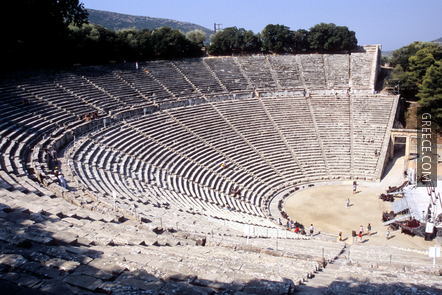General Information on Epidaurus
Epidaurus is one of the most important ancient sites in Greece. It is situated in the eastern Peloponnese, 62km south of the Corinthian Canal and belongs to the prefecture of Argolis. Epidaurus was a sanctuary of Asclepius, god of healing, son of Apollo. To be exact, Epidaurus was the most popular health centre of ancient times, called “The Asclepion”.
During the 4th and 3rd century B.C., the building was expanded and partly reconstructed, as part of a Roman reconstruction program. The centre was visited by ill people in hope of a cure; they shared rooms, called “Enkoimitria”. According to the myth, Asclepius would appear in their dreams and cure them of their disease. However, some nearby thermal springs were probably the reason of their cure. Epidaurus also has a theatre, whose magnificence still stands. The theatre is in complete harmony with its surroundings, which were taken into account when the monument was being built. As a result, the theatre can host not only plays, but also symposia, and is known as the ceremonial Hestiatoreion.
As Greeks highly valued sports, the theatre could also become a wrestling arena. All these activities were extensively practised here during ancient times. Another advantage of the place is its acoustics. Every spectator can hear the play perfectly, no matter where they are seated. It is said that if a pebble is dropped in the centre of the stage, it can be heard from every seat of the theatre.
History of Epidaurus
According to Greek mythology, Asclepius was the son of Apollo and Coronis. While giving birth to Asclepius, Coronis was struck by a thunderbolt and died. Apollo and his son went to Mountain Pelion, where physician Chiron taught the boy in the healing arts. Apollo was worshipped in Epidaurus, during Mycenaean and Archaic times but, by the 4th century B.C., he was sidelined by his son. Epidaurus became famous as the birthplace of Asclepius and the most important sanctuary of the Classical world.
Epidaurus was not considered part of Argolis until Roman times. With its surroundings, it formed the territory of Epidauria; the sanctuary prospered during the 4th and 3rd centuries B.C. when an ambitious building programme of expanding and rebuilding of monuments started. Fame and prosperity continued throughout the Hellenistic period. In 87 B.C. the sanctuary was looted by Roman general Sulla and, in 67 B.C., it was plundered by pirates. In the 2nd century A.D., the sanctuary enjoyed a new peak under the Romans, but in 395 A.D. the Goths raided it. Even after the introduction of Christianity and the silencing of the oracles, the sanctuary in Epidaurus was still famous as late as the mid-5th century A.D., even though as a Christian healing centre.
It is believed that one of the curative practices at the sanctuary was to be licked by snakes. Other treatments involved diet instruction, herbal medicines and even surgery.
Towns & Villages in Epidaurus
Palia Epidaurus: This village owes its name in part to the way it looks, to the point that it seems like time has not touched this area. To be exact, visitors are usually amazed by the fact that this village still matches Homer's descriptions. According to him, the village was mainly a religious centre, characterised by the worship of Asclepius. However, the religious inclination of the ancient inhabitants did not end in forming a cult of Asclepius. In fact, according to the surviving monuments in Palea Epidaurus, there were more popular gods, such as Apollo, Hera, Artemis and Dimitra. Palia Epidaurus was one of the main cities of Argolis and its prosperity dates back to antiquity. This was due to its strategic position, as it is close to Corinth, Piraeus, Aegina, Trizina, Argos and Nafplio. In addition to the restored sites of ancient Epidaurus (sanctuary, theatre), the cultural and tourist legacy of the village of Palea Epidaurus also contribute to its uniqueness.
Nea Epidaurus: The settlement is located at the foot of Mountain Akros, 7km north of Palia Epidaurus. Like many other Greek villages, Nea Epidaurus is very picturesque with traditional houses and narrow streets. Next to the village, at the slopes of the mountain, lies the beautiful gorge of Vothila. Apart from its natural beauty, important historical places to visit are the old Byzantine castle, the monastery of Pamegiston Taxiarchon near Dimena and the 11th century monastery of Agnountos, the oldest in Epidaurus.
Beaches in Epidaurus
Palia Epidaurus Beach: The closest beach to the coastline town of Palia Epidaurus is called Gialasi. It is a 1km-long beach with pebbles and sand, surrounded by lush green pine trees. The beach has tourist facilities, although the general rule here is to keep things as natural as possible. Moreover, the beach at Palia Epidaurus keeps the same philosophy, letting the tourist come in contact with the past of the place.
How to Reach Epidaurus
There are buses from Nafplio to Epidaurus (40 minutes) via Ligourio. Also, there are daily buses to/from Athens (2½ hours).
Weather in Epidaurus
The weather in Epidaurus is a mild Mediterranean. Summer is warm, dry and the sky is clear, while winter is usually rainy. As with the rest of the Peloponnese cities, Epidaurus doesn't have strong climatic variations.
Top 10 Destinations in Epidaurus
All Destinations in Epidaurus
Map of Epidaurus
 Athens Photos
Athens Photos
 Santorini Photos
Santorini Photos
 Crete Photos
Crete Photos
 Meteora Photos
Meteora Photos
 Corfu Photos
Corfu Photos






















